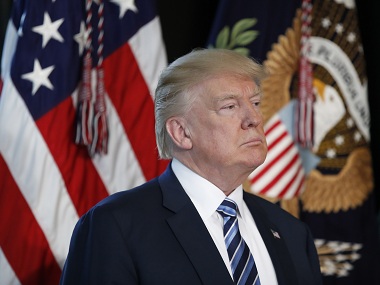On 27 April, 2016 when Donald Trump was still a presidential hopeful, he announced his “America First” policy. In his speech, he slammed Hillary Clinton, his rival and former secretary of state for her “directionless and disastrous” foreign policy for which he blamed the rise of the Islamic State in the Arab world. The billionaire’s speech signaled that Trump would bring about a marked shift in the Washington’s foreign policy, which has earned infamy for its military escapades across the world.
The common consensus that emerged within the international community with respect to Trump’s foreign policy was that it would largely be “inward-looking” and “non-interventionist”. The 70-year-old’s inaugural speech too, focused on catering to his domestic audience rather than the international community.
On the day of his inauguration as the 45th president, the Trump administration’s manifesto was formally unveiled on the White House website. Under the category of “America First Foreign Policy”, the first line read, “Peace through strength will be at the centre of that foreign policy. This principle will make possible a stable, more peaceful world with less conflict and more common ground.”
While the statement seemed to suggest that Uncle Sam would abandon a hawkish foreign policy for a more dovish one, the pertinent question after 100 days of the Trump administration is whether the dispensation has really lived up to its promise of employing a less-interventionist foreign policy. If Trump’s handling of the Syria and North Korea crises, along with the airstrike in Afghanistan, are anything to go by, then it seems that his promise of a new policy does not seem to hold water.
After the sarin gas attacks over civilians allegedly by pro-Assad forces, the Trump administration immediately launched Tomahawk cruise missiles targeting an airbase in Assad-controlled territory.
While condemning the gas attack over innocents, he urged “all civilised nations to join the US in seeking to end the slaughter and bloodshed in Syria.”
However, his sudden decision to attack Syria came as a surpris: Trump had been vehemently opposed to any military intervention in Syria ever since the conflict broke out in 2011. In fact, in 2013, Trump tweeted that both rebels and the Assad government were “bad’.
Trump’s decision to attack Syria had rattled his core supporters – many of whom belong to the Alt-Right movement, which discourages any foreign intervention. Many of his hardcore supporters like Ann Coulter, Infowars’ Alex Jones and blogger Mike Cernovich slammed Trump for buying the narrative driven by the “fake news media”.
But it wasn’t just Syria where Trump apparently flipped. The dropping of MOAB (colloquially called the Mother Of All Bombs) on Islamic State positions in Afghanistan can also be viewed from the prism of his reneging on the campaign promise of non-intervention.
However, Trump does have an excuse for this decision. During his campaign, Trump had promised to destroy the Islamic State.
After the attack, which reportedly killed 90 militants, former US diplomat William H Avery, was quoted by ABC News as saying, “I think he is following up on campaign promises, leaving America first to one side for a moment — he did say that the wanted to bomb the hell out of ISIS,” Nevertheless, the Afghanistan attack showed that Trump is open to surprise military operations in war-torn countries.
Thousands of miles away from the battle ground of Syria, the ongoing crisis with North Korea will be the real test of his “America First” policy. The Trump administration has given mixed signals so far. When all 100 Senators were invited by the president for a briefing on North Korea’s missile and nuclear programme, the expectations from the meeting were alarmingly high.
However, as noted by a Vox report, the briefing failed to clarify even the basic questions about the crisis. On the other hand, Trump while speaking to Reuters on Thursday, dropped a bombshell: There is a chance that the United States could end up having a major, major conflict with North Korea, Trump said.
On the same day, US Secretary of State Rex Tillerson said that the US would directly talk to the North Koreans, a scenario which has never materialised in the last seven decades. Such mixed signals from the administration, has put the “America First” policy in limbo. The crisis is further complicated: Trump is insisting his ally Seoul pay for the $1 billion anti-missile THAAD system. Trump’s posturing on the payment row perfectly fits his policy of “America First”: the US has been paying for the maintenance of security systems in South Korea.
However, Trump has to tread a narrow path on the Korea problem, a legacy of the Cold War between the US and the Soviet Union. Side-stepping the crisis, which threatens to engulf the whole of east and southeast Asia, under the banner of “America First” would be detrimental to American strategic interests in the region.
With Trump’s pre-World War I era-like isolationist policy, China, the emerging “superpower” may very well fill the vacuum left by the US and strengthen its hold in the East Asia. A China-backed North Korea may be Washington’s next big headache in the days and years to come.
The world has witnessed two military strikes in the first 100 days of Donald Trump. It is to be seen whether Trump maintains his “non-interventionism” in North Korea and other future crises or ends up reneging on his promise.
)
)
)
)
)